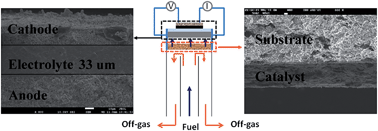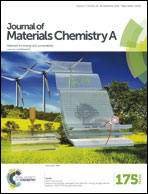In situ fabrication of (Sr,La)FeO4 with CoFe alloy nanoparticles as an independent catalyst layer for direct methane-based solid oxide fuel cells with a nickel cermet anode†
Abstract
An independent catalyst layer is applied to develop a highly effective way to reduce coking when operating in methane based fuels, in which the catalyst layer is separated from a Ni cermet anode. In this way, Ni cermet anode conductivity is not influenced, and cell cracking due to the thermal–mechanical stress from the mismatched thermal expansion coefficients (TECs) between the catalyst and anode materials, the temperature gradients within the anode caused by the highly endothermic reforming reaction of methane, and the large internal strain during the reduction process is also avoided. La0.6Sr0.4Co0.2Fe0.8O3−δ (LSCF), which is co-pressed with an Al2O3 substrate into a double-layered slice with a mesoporous structure, functions as an independent catalyst layer of the Ni-based anode. Under SOFC operating conditions, a K2NiF4-type oxide (Sr,La)FeO4 with homogeneously dispersed CoFe alloy nanoparticles is formed, which shows good catalytic activity for methane partial oxidation with 88% conversion at 950 °C in a mixture of CH4 and O2 (1 : 1). A conventional cell with the state-of-art Ni cermet anode (NiO–8% Y stabilized ZrO2 (YSZ)/YSZ/La0.8Sr0.2MnO3–YSZ) is constructed and the electrochemical performance of cells with and without the independent catalyst layer is tested. In wet methane, the voltage of the conventional cell without the catalyst layer declines rapidly from 0.7 V to 0.1 V within 20 min at 333 mA cm−2 and 800 °C. In contrast, the voltage of the modified cell with an independent catalyst layer stabilizes at 0.79 V with negligible degradation within 116 h. In wet coal bed methane (CBM), the voltage of the modified cell with an independent catalyst layer exhibits a slow decrease from 0.69 V to 0.66 V within 12 h. The stable power output of the cell with an independent catalyst layer under a constant current load in methane indicates excellent coking resistance. The microstructure and surface composition of the catalyst layer and anode are further analyzed by SEM and EDX after the stability test.


 Please wait while we load your content...
Please wait while we load your content...